QuestionYou deserve the ratings! This is a whole new experience for me. This is my first clutch that actually lived. In fact I have never bred any birds until this one. So everything is a learning experience for me. I just wasn't expecting to jump right into the hand feeding thing. I didn't get up with him last night but his crop was really full before we went to bed and that was about 12:30 am my husband is always up by 7:30 or 8 so he feeds the baby when he gets up. He seems to have a slow moving crop. I did sleep a little better last night though. We started using the pedialite right before we went to bed last night and his skin all ready looks so much better. It is starting to look moist and we can see his tiny pin feathers starting to come in. Along with the right heat and humidity I think he is going to be just fine. He seems pretty content, I get nervous though, when I feed him he latches on to the eye dropper like its going out of style and I don't like that. We got one last night that has a curve at the tip its better than the syringe that I was using. I know I'm supposed to let them guide me but that just makes me nervous.Any way, if I have more questions I'll try to locate you again you have been a great big help. Thanks--Andrea------------------------
Followup To
Question -
Hi again, believe it or not I am using an old fish aquirium with my husband lava lamp lightbulb set up (it is 40 watts) and I do have a glass dish filled with water underneath him, I have him sitting on a metal basket that I had gotten a few years ago for Christmas it was filled with bottles of shower gel and body sprays. Any way, s/he will not be able to get into the water. I have read that giving babies pedialite will also help hydrate the baby, what is your opinion in this? I also have a window screen covering the tank (to keep nosy dogs way from him) He does sqawk at me a lot and seems to know when I am there. I am thinking that he is at least 5 days old but he has not opened his eyes yet. When do they usually open them?-------------------------
Followup To
Question -
-------------------------
Hi, I have removed the baby from the cage and have set up a make-shift heating system. I was a diabetic and had extra needles(clean unused)I am not using the actually needle just the syringe part. As of right now I do not have the hand feeding food that I have read about but I have made up an egg-based food and he is eating from the syringe right now. Hopefully he will last a few more days. I have been trying to learn as much as I can through other breeders and you were a big help, Yes, I was talking about Zebra's. Thanks--Andrea
Question -
My finches have just hatched their second clutch a week ago, two of them died within the first three days. We thought that out of the three that remained would survive, they were getting more feathers and were getting quite big. This morning two of the three died and now the mama doesn't want anything to do with the one remaining. I have never hand fed a baby. Actually, I am new to this all together. I am aware and I feel are still quite young themselves. The mama is approx. 4 months old. The male I'm not sure. I want this baby to survive, how can I help it.
Answer -
Hi, Andrea. Thanks for posting your questions.
You didn't state what type of finches you have, so I'm going to assume you are referring to zebra finches or the small finch breed.
It would be nearly impossible to handfeed a baby finch. They are just too small. It's difficult to handfeed a very young parakeet/budgie, even if you know what you are doing! They are just too small and z finch is small than this. I don't even know if an eye dropper would be small enough to handfeed a baby zebra finch. There is so much you need to know when handfeeding that I don't think you have enough time to learn before you can save this last baby (the baby will starve before you learn what you need to know and have the food, etc., you need to handfeed/keep it). Usually, when a parent bird won't feed one (or more) of their babies, there's usually something wrong with the baby(ies) that we don't know, but the parent bird knows.
Finches are very prolific breeders and have many babies in a single clutch. Due to these facts, there is a high mortality rate, i.e., you'll see many babies that don't survive. This is usually true in bird species (or any animal species) that lay many eggs and produce many clutches per year.
I used to breed zebra finches. I always kept pairs of society finches at hand to foster baby zebra finches to. Society finches will foster other types of finch babies. If you continue to breed zebra finches, I would recommend keeping some society finches on hand in case you run into this problem in the future. I colony breed my finches and kept the societies in the same aviary with my zebras. I would regularly move eggs/babies from the zebras to the societies. If you continue to breed finches, you could colony breed them or breed them separately in cages. When necessary, you could move zebra eggs/babies to the societies. In addition, you need to learn how to handfeed baby finches BEFORE letting your finches breed again so you'll know what to do if/when you run into a situation like this again. If you do not want to breed finches, you'll need to separate the males and females. If you keep the sexes together, you'll soon be overrun with finches, so you'll need to control your population and/or go into the finch selling business! You can easy triple the number of finches you have in about 6 months if you let them breed at will. And, the more birds you have, the higher the mortablity rate (i.e., the more deaths you will encounter).
Sorry I couldn't be more positive for you about the last baby finch. I think it's most likely too late to help this baby. The time it took for you to post this message, me to respond/you get my response, and you get the equipment/food and learn what you need to learn to help this baby, the baby will be gone. You need to be prepared in advance for this type situation.
Chrys
Answer -
Andrea,
The wheat germ oil will lubricate his insides and might cause him to have diahreah. What he needs is humidity. The temperature of 98 degrees on the inside is good...this high temp will dry s/he out quickly, so humidity is needed. Suggest you attach a dish of water somehow inside the "brooder" where the baby can't get inside the dish (so s/he won't drown in the water if s/he would happen to get into the dish). Perhaps you can hang a feeding cup with hooks from the side of the brooder. This will provide humidity. To keep track of humidity, you need a hygrometer (I may not have spelled this correctly). I don't know what type of setup you have, but with an incubator type piece of equipment for example, water can be placed in the bottom with a piece of screen or very small wire or something like this placed completely over the water area, the baby can be placed on the screen/wire, and the entire setup is enclosed in order to keep the heat and humidity inside. You could also ensure that you give the baby a drink of water many times during the day, especially after feeding to wash the food down, and this will help from the inside out. The baby could be dehydrated and this isn't good.
I give you a lot of credit for working with such a small little guy and trying to save his life. Not many people would go to this length. You must really love animals, as I do!
Keep me informed of his progress. I'm really interested in how successful you are with this little guy. You will end up with a very tame little zebra finch if s/he survives.
Chrys
Hi, again, Andrea. This is GREAT! I didn't have any idea if you knew anything about handfeeding baby birds. Some people think handfeeding is putting seed in your hand and letting the baby bird eat the seed from your hand! If you can buy some baby parrot handfeeding formula from a local pet shop, this would probably be better food for the finch baby. It has what baby birds need to survive. I use Kaytee Exact, but there are other brands, such as Pretty Bird, Hagan, etc. I have also used liquid nutritional food supplements for humans, such as Ensure Plus, Slim Fast, etc. (vanilla only), which works out very well...full of calories and many vitamins and nutrients. You can mix this liquid with human strained baby food until you can get your hands on baby bird handfeeding formula.
Good luck with the baby finch.
Chrys
Answer -
Andrea,
I wanted to thank you for the nice ratings. You need to feed the finch whenever his crop is nearly empty to empty. I've never handfed a baby finch, so I don't know how often this would be. A baby parakeet (7-10 days old) needs to be fed every 4-5 hours, except during the night (first feeding would be about 6-7 AM, last feeding would be at about 10 or 11 PM).
If the baby finch is 5 days old, you may not need to feed him during the night (between 11 PM and 6/7 AM), but you should check on him at least once during the night until he is 7-10 days old. His little tummy can't hold much food at one time and empties quickly and he'll also sleep better when his tummy is full!
Chrys
Yes, Pedialyte (unflavored preferred) works well for hydration when you have a sick bird who has diahhrea or is vomiting, etc. You can mix the feeding formula with the pedialyte (heat the pedialyte first) and/or give separately. I'm sure you know that any food/water you put into the baby's mouth should be 102 degrees F?
I use fish aquariums with a heating pad underneath for all my baby parrots! With the heating pad underneath, you don't have to have light on the baby all the time (they sleep a lot) and s/he still stays warm (particularly at night). I can't remember for sure (been too many years since I bred finches), but s/he should open it's eyes at about 7 days.
Chrys
AnswerHi, Andrea,
I don't believe if the baby is dehydrated that it would keep his eyes from opening. Parrot babies sometimes don't open their eyes until 7-8 days of age (depending on the species), so I really wouldn't worry too much about this unless s/he becomes 10 days old and they still haven't opened. S/he should be opening it's eyes any day now. You might want to check and see if there is anything matted around it's eyes and/or gently wipe them using a clean cotton ball soaked with very warm water. Don't try to force them open...just wipe them off. Sometimes during handfeeding, some handfeeding formula can get on your fingers and then in the baby's eyes causing them to stay closed, depending on how you hold the baby during handfeeding. I steady the baby's head with my fingers on each side of it's head during handfeeding to ensure I get the syringe in the right place when the baby bobs it's head and so I don't accidently poke the baby in the eye with the syringe!
One way to tell if the baby is dehydrated is to gently pull a little bit of skin away from the baby's body and let go. If the skin stays away from it's body (or takes time to go back in place), it's dehydrated. If the skin goes back in place freely rather quickly, the baby isn't dehydrated. For instance, on it's back or under it's wings...any place you can get a little bit of skin between 2 fingers. Just kind of pull the skin away from the body a little bit (as if you were going to pinch the baby) and see what it does. It should go back in place right away if not dehydrated. Hard to explain in writing, so I hope you understand what I mean. If s/he appears to be dehydrated, just give as much water as possible. To be honest with you, I don't provide my baby parrots with hydration, i.e., water in a dish in their brooder when I'm handfeeding them. I feel they get plenty of water in their handfeeding formula and I always give them a drink at the end of each handfeeding. I check them constantly to ensure they aren't dehydrated, but I don't worry too much about this. In 16 years, I've never had a dehydrated baby. If this little finch were dehydrated, I don't think s/he would have lived this long and other things would be going wrong, but you can do the skin test just to be sure. Sufficient water is VERY IMPORTANT for survival...probably more important than food in the long run, so I'll bet s/he is OK.
Wanted to tell you a couple things you may/may not know about finches. They are soft-billed birds. Birds with hooked beaks are parrots, even parakeets. Birds with straight beaks are soft bills. Zebra finch parents identify their babies by the dark patterns inside the babies' mouths. Each baby has it's own unique pattern of spots/designs inside it's mouth, and this is how the parents recognize them as their own! Pretty cool!
Chrys
============================
Andrea,
If his crop is moving slow, trying increasing the temperature of the food to 102 degrees F. Crop slow down and crop stasis (stasis meaning the crop stops functioning all together) is usually due to the food not being warm enough. The food needs to be the same temperature as his body when the food is fed to him, not when you are mixing the food. What I usually do is get the food to the right temperature, fill up a syringe, then place the syringe filled with food into a cup (insulated cup if available) of hot water. This will keep the food at the right temperature until fed. The temperature starts dropping as soon as you mix the food so this is important. You can place the syringe back down in the hot water in the cup in between his gulps to keep the food the right temperature. I usually bring my baby birds right to the kitchen sink (in a shoebox or something like this) when it's time for feeding so I can get the food into them as soon as possible after mixing to ensure the temperature is correct. It's also easier to clean up right at the sink when they/I make a mess instead of messing up their bedding. It doesn't hurt them to be away from their heated environment for this short period of time (as long as they don't get chilled/cold...keep them covered with a wash cloth or something).
Also, his environment needs to be kept the right temperature or his crop will slow down. What you can do is place some warm water/pedialyte only in the crop and massage the crop very gently on the outside with your fingers to try and get the food that remains in the crop softened up and moving again. In other words, if food is still in the crop when you are ready to feed him the next feeding, put the warm water in the crop first, massage, then fill him up the rest of the way. This is a reason why it's also important to ensure the crop is completely empty before feeding again. If not, crop slow down/statis can occur and/or bacteria, etc., can develop in the crop in the food that remains between feedings. As he grows, he'll need more food at each feeding. If he's getting pin feathers, soon you'll be able to lower the temperature of his environment as the feathers develop. I like to keep one section of the aquarium free of the heating pad so in case the baby(ies) get too hot, they can move themselves to the cooler area so they don't overheat (they move back when they need to).
It's good that he's practically eating the syringe when you feed! This means he has the hang of it now and feeding will be easier. Parakeet babies are like this...they are small but easy to handfeed for this very reason. I think they are easiest of many parrots to feed for this reason. It's OK if he nearly swallows the tip, but just be careful that you/he don't damage the inside of his mouth/throat with the tip of the syringe (if s/he bobs his head during feeding). Actually, the closer you can get the food into the crop, the less chance of food going down into the trachea, which can result in pneumonia or aspiration. It would be like us getting fluid into our lungs. As a matter of fact, "gavage" feeding is introducing food directly into the crop, which is what a person needs to do with a sick bird who can't/won't eat on it's own. In gavage feeding, a tube is inserted down the throat directly into the crop for feeding. This process can also be used to withdraw food from the crop when crop statis occurs (or when the crop needs to be cleaned out completely due to bacterial/fungal, etc., problems). You're learning more than you actually realize you're learning!
When he opens his eyes, he will see you/your hubby and will soon after recognize you both by sight. He will LOVE your hands/fingers as a result of being handfed, too. This is why parrots are pulled for handfeeding before they open their eyes...so they will imprint on their humans instead of their paraents and make good pets. They won't be afraid of fingers/hands because they associate these with being fed. After a while, any time s/he comes in contact/sees your hands/fingers/you, you will beg to be fed. This is why I said that you will end up with a very tame little finch. You will most likely be able to train this finch to sit on your finger/shoulder, etc., like the larger parrots, which is a very rare thing for finches. You might want to consider keeping this little guy for a pet.
You can start the weaning process after he has had his eyes open for a couple weeks (not sure how long exactly for a finch) and starts pecking at stuff in the bottom of his aquarium. Contact me for help with this when you get to that point.
I have a website that might provide some additional information for you on birds in general:
http://www.angelfire.com/falcon/birdinfo.index.html
Chrys

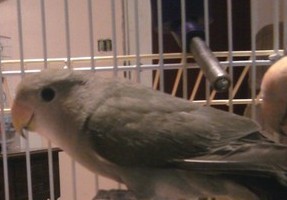 My odd lovebird
Question
Honey
I have a love bird that is approximately
My odd lovebird
Question
Honey
I have a love bird that is approximately
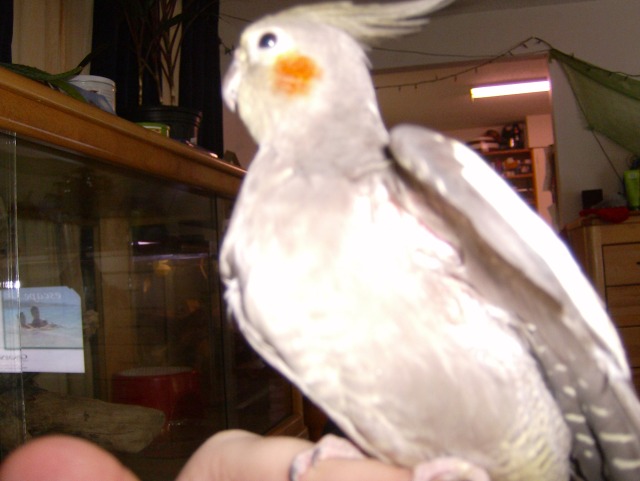 my cockitale mocha
QuestionQUESTION: I have a cokitale that will be 3 on A
my cockitale mocha
QuestionQUESTION: I have a cokitale that will be 3 on A
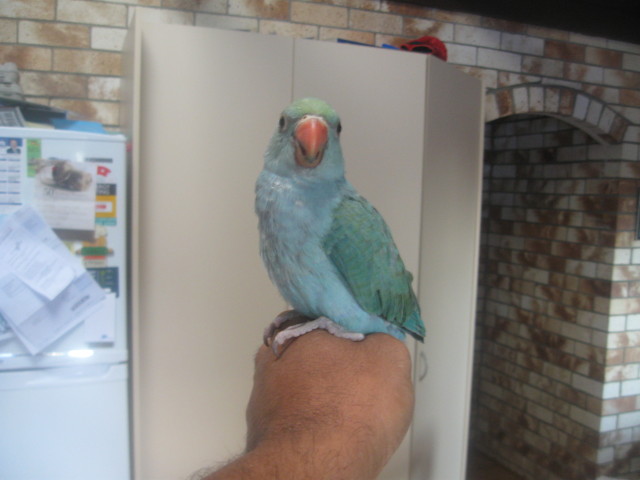 Color of my indian ringneck
Question
Boots
I have an eleven week old male ringneck
Color of my indian ringneck
Question
Boots
I have an eleven week old male ringneck
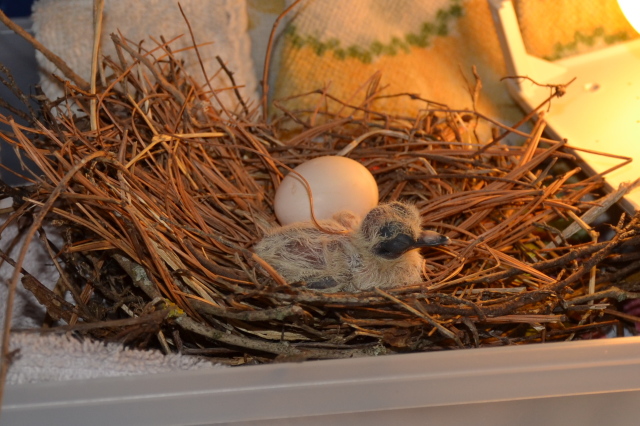 mourning dove
Question
baby mourning dove
Hello,
My boys found a baby
mourning dove
Question
baby mourning dove
Hello,
My boys found a baby
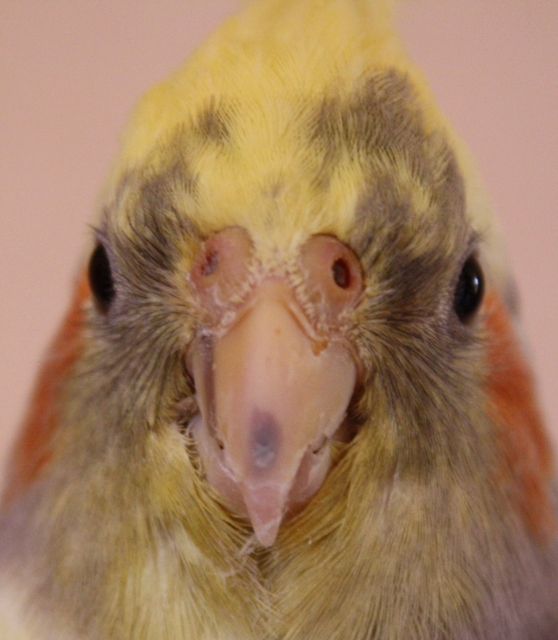 Bruise-like discoloration of beak (Cockatiel)
QuestionSasha
QUESTION: Our Cockatiel has develo
Bruise-like discoloration of beak (Cockatiel)
QuestionSasha
QUESTION: Our Cockatiel has develo